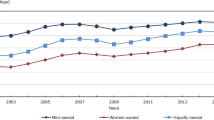Abstract
Using project data from a random sample of Phase II research awards from the National Institutes of Health SBIR program, we estimate the relative probability that woman-owned firms are able to attract private investments to fund the transition of the technology developed under the sponsorship of the SBIR program to an innovation to enter the market. We find that women-owned firms are as much as 16% points less likely to attract private investment dollars compared to male-owned firms, factors excluding the size of the SBIR award held constant. Women-owned firms that received larger awards performed substantially better. Although the SBIR program has a legislated directive to increase the participation of woman-owned firms in the program, our findings suggest that it might not be sufficient to overcome market perceptions about the profitability of such investments actually bringing a developed technology to market.
Similar content being viewed by others
Notes
The term Valley of Death is generally attributed to Congressman Vernon Ehlers (1998, p. 40). Branscomb and Auerswald (2002) refer to the Valley of Death as the transition stage from science-based invention to commercial innovation during which venture capital is the primary alternative source of investment. According to Wessner (2007, p. 7): “The difficulty of attracting investors to support an imperfectly understood, as yet-to-be-developed innovation is especially daunting. Indeed, the term ‘Valley of Death’ has come to describe this challenging transition when a developing technology is deemed promising, but too new to validate its commercial potential and thereby attract the capital necessary for its development.”
According to Schumpeter (1934, p. 78), the entrepreneur is the person who innovates, who makes new combinations in production: “everyone is an entrepreneur only when he actually ‘carries out new combinations,’ and loses that character as soon has he has built up his business, when he settles down to running it as other people run their business.” Thus, bridging the Valley of Death is an entrepreneurial responsibility. See Hébert and Link (2006, 2009).
The Diana Project, named after the Roman goddess of the hunt and thus symbolizing women’s hunt for the rewards of entrepreneurial effort, was a multi-university research program to identify factors that support and enable high growth in women-led ventures. This project was funded by the Kauffman Foundation, the U.S. Small Business Administration, the National Women’s Business Council, and the Swedish Institute for Small Business Research (Gatewood et al. 2009).
As Wessner (2009) has shown with regard to entrepreneurial firms in the United States funded by Small Business Innovation Research awards, the focal data in this paper, venture capital is an infrequently available source of alternative private investments.
Gompers and Lerner (2004) also review the literature related to each of these factors.
Being considered under the current temporary reauthorization of the SBIR program (to November 18, 2011 under H.R. 2608) are caps on Phase I awards of $150,000 and $1,000,000 on Phase II awards. These caps are effective under a March 30, 2010 amended SBIR policy directive initiated by the U.S. Small Business Administration. These caps are expected to be made when the program is reauthorized.
See also Levin et al. (1988), Johnson and Powell (1994), Barsky et al. (1997), Jianakoplos and Bernasek (1998), Sundén and Surette (1998), and Borghans et al. (2009). Schubert et al. (1999) present findings that question the prevalence of such a gender-specific risk attitude. However, research in the field of psychology shows that men and women are equal in terms of their innate creativity (Baer and Kaufman 2008).
This lack of risk taking could be related to a lack of self-confidence, and Brana (2011) discusses the latter in the context of gender and entrepreneurial ventures.
This argument suggests that one should compare the probability of a research project being supported by private investment between projects funded and not funded by SBIR. While a matched pairs analysis would be interesting, such data are not available in the NRC database, and may not be available at all. Although Lerner (1999) has compared a large sample of SBIR awardees and matching firms, finding that the SBIR recipients have higher employment growth, Lerner and Kegler (2000, p. 321) explain that it is difficult with the matched pairs analysis “to disentangle whether the superior performance of the awardees is due to the selection of better firms or the positive impact of the awards.”
There are 22 different agencies within the NIH that funded the 323 projects in the main estimation sample. The agencies that funded the most projects are the National Cancer Institute (53 projects) and the National Heart, Lung and Blood Institute (37 projects).
Since this variable conveys similar information to the Phase II award amount, it is not surprising that including it slightly reduces the absolute value of the coefficients on Award and Award·Female: to −0.0095 and 0.3393, respectively.
The most likely reason is that, similar to private investment for Phase III research, pre-Phase II funding is also highly correlated with gender. Of the projects in the sample, 21% of male firm owners received private research funding prior to the Phase II award, compared to only 6% of female firm owners. This difference is statistically significant.
We also re-estimated the model with a polynomial in Age and did not find a relationship. These results are available from the authors upon request.
The mean and standard deviation conditional on positive investment are 4.8425 and 15.1991, respectively.
The results from the specifications in columns (1) and (2) in Table 5 are available on request from the authors.
These coefficients show how the dependent variable changes when we change the X variables when Private investment equals 1, ignoring the changes in the probability of receiving Phase III funding associated with changes in the independent variables.
References
Aldrich, H. E. (1989). Networking among women entrepreneurs. In O. Hagen, C. Rivchum, & D. Sexton (Eds.), Women-owned businesses (pp. 103–132). New York: Praeger.
Baer, J., & Kaufman, J. C. (2008). Gender differences in creativity. Journal of Creative Behavior, 42, 75–106.
Barsky, R. B., Juster, F. T., Kimball, M. S., & Shapiro, M. D. (1977). Preference parameters and behavioral heterogeneity: An experimental approach in the health and retirement study. Quarterly Journal of Economics, 112, 537–579.
Blanchflower, D. G., & Meyer, D. B. (1994). A longitudinal analysis of the young self-employed in Australia and the United States. Small Business Economics, 6, 1–19.
Blanchflower, D. G., & Oswald, A. J. (1998). What makes an entrepreneur? Journal of Labor Economics, 16, 26–60.
Borghans, L., Heckman, J. J., Golsteyn, B. H. H., & Meijers, H. (2009). Gender differences in risk aversion and ambiguity aversion. Journal of the European Economic Association, 7, 649–658.
Brana, S. (2011). Microcredit: An answer to the gender problem in funding? Small Business Economics. doi:10.1007/s11187-011-9346-3.
Branscomb, L. M., & Auerswald, P. E. (2002). Between invention and innovation: An analysis of funding for early-stage technology development. NIST GCR 02–841. Washington, DC: U.S. Department of Commerce.
Brush, C. G., Carter, N., Gatewood, E., Greene, P. G., & Hart, M. M. (2001). An investigation of women-fed firms and venture capital investment. Final Report submitted to the U.S. Small Business Administration, Office of Advocacy.
Colombo, M. G., Luukkonen, T., Mustar, P., & Wright, M. (2011). Venture capital in high-tech start-ups. Venture Capital, 12, 261–266.
Croson, R., & Gneezy, U. (2009). Gender differences in preferences. Journal of Economic Literature, 47, 448–474.
Ehlers, V. J. (1998). Unlocking our future: Toward a new national science policy. Washington, DC: U.S. House of Representatives, Committee on Science.
Executive Office of the President. (2011). Report to the President on ensuring American leadership in advanced manufacturing. Washington, DC: President’s Council of Advisors on Science and Technology (PCAST).
Fairlie, R., & Marion, J. (2010). Affirmative action programs and business ownership among minorities and women. Small Business Economics. doi:10.1007/s11187-010-9305-4.
Gatewood, E. J., Brush, C. G., Carter, N. M., Greene, P. G., & Hart, M. H. (2009). Diana: A symbol of women entrepreneurs’ hunt for knowledge, money, and the rewards of entrepreneurship. Small Business Economics, 32, 129–144.
Gompers, P., & Lerner, J. (2004). The venture capital cycle. Cambridge: MIT Press.
Hébert, R. F., & Link, A. N. (2006). The entrepreneur as innovator. Journal of Technology Transfer, 31, 589–597.
Hébert, R. F., & Link, A. N. (2009). A history of entrepreneurship. London: Routledge.
Jianakoplos, N. A., & Bernasek, A. (1998). Are women more risk averse? Economic Inquiry, 36, 620–630.
Johnson, J. E. V., & Powell, P. L. (1994). Decision making, risk and gender: Are managers different? British Journal of Management, 5, 123–138.
Lerner, J. (1999). The government as venture capitalist: The long-run impact of the SBIR program. The Journal of Business, 72, 285–318.
Lerner, J., & Kegler, C. (2000). Evaluating the small business innovation research program: A literature review. In C. W. Wessner (Ed.), The small business innovation research program: An assessment of the department of defense fast track initiative (pp. 307–324). Washington, DC: National Academy Press.
Levin, I. P., Snyder, M. A., & Chapman, D. P. (1988). The interaction of experiential and situational factors and gender in a simulated risky decision-making task. Journal of Psychology, 18, 173–181.
Link, A. N., & Scott, J. T. (2009). Private investor participation and commercialization rates for government-sponsored research and development: Would a prediction market improve the performance of the SBIR program? Economica, 76, 264–281.
Link, A. N., & Scott, J. T. (2010). Government as entrepreneur: Evaluating the commercialization success of SBIR projects. Research Policy, 39, 589–601.
Link, A. N., & Scott, J. T. (2011). Employment growth from public support of innovation in small firms. Kalamazoo, MI: W.E. Upjohn Institute for Employment Research.
Link, A. N., & Welsh, D. B. (2011). From laboratory to market: On the propensity of young inventors to form a new business. Small Business Economics. doi:10.1007/s11187-011-9345-4.
Marlow, S., & Patton, D. (2005). All credit to men? Entrepreneurship, finance, and gender. Entrepreneurship Theory and Practice, 29, 717–735.
National Venture Capital Association. (2011). Yearbook 2011. Arlington, VA: National Venture Capital Association (NVCA).
Nelson, R. R. (1982). Government stimulus of technological progress: Lessons from American history. In R. R. Nelson (Ed.), Government and technical progress. New York: Pergamon.
Reynolds, P. D. (1997). Who starts new firms? Preliminary explorations of firms in-gestation. Small Business Economics, 9, 449–462.
Ruef, M., Aldrich, H. E., & Carter, N. M. (2003). The structure of founding teams: Homophily, strong ties, and isolation among U.S. entrepreneurs. American Sociological Review, 68, 195–222.
Schubert, R., Brown, M., Gysler, M., & Brachinger, H. W. (1999). Financial decision-making: Are women really more risk averse? American Economic Review Papers and Proceedings, 89, 381–385.
Schumpeter, J. A. (1934). The theory of economic development. Cambridge: Harvard University Press.
Sundén, A. E., & Surette, B. J. (1998). Gender differences in the allocation of assets in retirement savings plans. American Economic Review Papers and Proceedings, 18, 201–211.
Tassey, G. (2010). Rationales and mechanisms for revitalizing U.S. manufacturing R&D strategies. Journal of Technology Transfer, 35, 283–333.
Uusitalo, R. (2001). Homo entreprenaurus? Applied Economics, 33, 1631–1638.
Van der Zwan, P., Ingrid Verheul, I., & Thurik, R. A. (2011). The entrepreneurial ladder, gender, and regional development. Small Business Economics. doi:10.1007/s11187-011-9334-7.
Von Gaudecker, H.-M., van Soest, A., & Wengström, E. (2011). Heterogeneity in risky choice behavior in a broad population. American Economic Review, 101, 664–694.
Wessner, C. W. (2007). SBIR and the Phase III challenge of commercialization: Report of a symposium. Washington, DC: National Research Council.
Wessner, C. W. (2009). An assessment of the SBIR program. Washington, DC: National Research Council.
Wright, M., Lockett, A., Clarysse, B., & Binks, M. (2006). University spin-out companies and venture capital. Research Policy, 35, 481–501.
Acknowledgements
This paper has benefitted from the comments and suggestions of Steve Bendar, Barry Hirsch, Donald Siegel, Mike Wright, and anonymous referees.
Author information
Authors and Affiliations
Corresponding author
Rights and permissions
About this article
Cite this article
Gicheva, D., Link, A.N. Leveraging entrepreneurship through private investments: does gender matter?. Small Bus Econ 40, 199–210 (2013). https://doi.org/10.1007/s11187-011-9411-y
Accepted:
Published:
Issue Date:
DOI: https://doi.org/10.1007/s11187-011-9411-y




